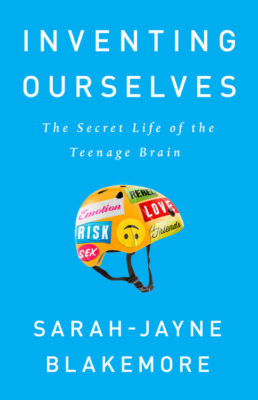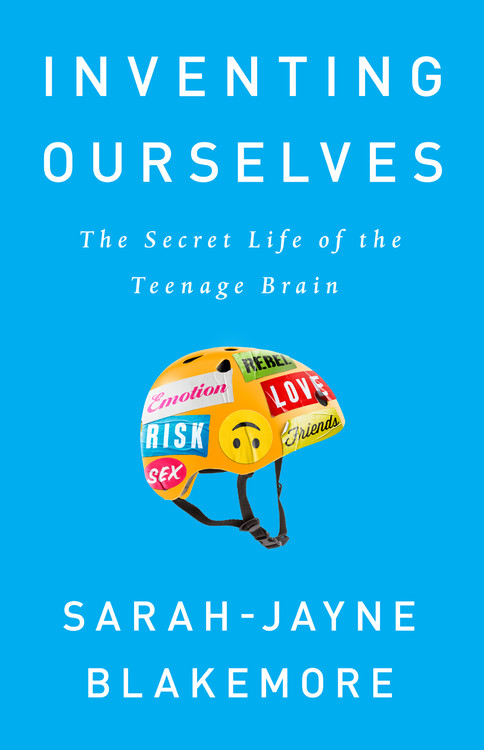Getting older is a bizarre experience.
When we’re young, we are, understandably, not very good at anticipating the sort of person we’ll one day become; only in hindsight do we realize that.
More surprising, or at least challenging to our sense of continuity, is that once through the veil of maturity, we’re just as poor at retrospection. It’s as if we’re reincarnated with mostly vague recollections of our previous life — we retain something of before, but we’re no longer the same person.
Cognitive neuroscientist Sarah-Jayne Blakemore’s book Inventing Ourselves is a fascinating examination of what recent decades of technological progress and investigation have shown us about the teenage brain.
In a slender 202 pages, Blakemore’s brisk but never insubstantial-seeming summary of her own work and that of many other researchers demonstrates the way in which adolescence is not just a useful marketing term or otherwise peculiar Western European sociological invention: it’s a profoundly distinct biological — and specifically neurological —period that humans and related mammals experience.

Technology has increased such that we can see the equivalent of high definition photos of how the brain looks while resting, as well as capture what it is doing performing specific tasks, and now has been going on long enough to compare the same individuals as they age.
Blakemore, a professor of cognitive neuroscience at University College London, did her doctorate at its Functional Imaging Lab and writes with the expectation that you know nothing about the way the brain functions, or at least with the presumption that it’s been a few years since last you learned of amygdalas, grey matter, and action potential.
It wasn’t necessarily a mistake to assume that readers curious about the way the teenage brain works picked up the book with no prior knowledge, but some of the particulars she includes, like London cab drivers or Phineas Gage and his skull-splitting tamping rod, are already staples so might be tedious.
Therefore, before getting into any of this, Blakemore wisely hooks you with some stories about her own life and adolescence.
Her brief, unassuming account of what it was like to grow up the child of a neurobiologist targeted by animal rights activists — whatever the scientific value, sewing shut the eyelids of newborn kittens was, in terms of public relations, perhaps the worst choice possible by her father — is immediately engaging in its own right but also illustrative of many of the themes she develops later.
Blakemore was actually not so afraid of the physical danger of mobs shouting outside her house or vandalizing their property as she was worried of police trailing her walk to school in their squad car.
Eventually, someone did indeed mail a pipe-bomb to their house that she nearly opened by mistake and may have killed her; however, she had only been mortified that her peers would think less of her because of all the attention.
She wasn’t exceptional.
Blakemore relates how researchers have been able to demonstrate in quantifiable ways how peer-opinion matters to adolescents and changes their behavior.
For example, teens (13–16) are not any more prone to risky speeding through stoplights than young adults (17–24) or adults (25+) so long as they’re driving alone. But put friends in the vehicle, too, and teens start getting into crashes much more frequently than young adults and older adults, who show no change.
While that particular example was a simulation, I was more surprised than I should have been that laws limiting young drivers and the types of passengers they can have a demonstrable justification.
If you’re like me, of course, you may have reacted with the equivalent of crossing your arms and skeptically hmphing, “Well how do we know this isn’t all just a result of the way we’re socializing children and teens?”
Blakemore did, of course, anticipate that, and includes examples of research such as how during their thirty-day period of adolescence, young mice will drink no more alcohol than adult mice if on their own but will tend to imbibe more generously when surrounded by others of their same cohort.
So we know that young mice, too, can be worryingly social drinkers under peer pressure! Which, by the way, is a much easier sell to the public when it comes to animal testing than something out of a lesser Saw series film.
She also talks about how brains aren’t this or that so much as they’re constantly becoming, especially in childhood and adolescence but even as adults.
Blakemore compares young minds to a startup company that hires tens of thousands of people before ultimately laying off the workers that show least activity.
This does, perhaps, fit too neatly into my expectations of why progressive policies are practically useful as well as ethically beneficial, but it’s nice to know evidence is there instead of wishful thinking. The target audience of this book is surely parents of children about to enter or amid their teenage years, but it’s a useful primer for all those who have to interact with that age.
To adults, a sensible anti-drinking campaign might be based on the life-or-death consequences of drunk driving or on chronic liver damage.
Thirteen year olds, though, may not believe that or care if they’re going to live that long anyway, so a message focusing on how being out-of-control intoxicated can make you subject to ridicule or do things you regret that ruin your relationships might actually be more impactful.
When your brain is wired for in-group approval, someone’s sage advice like, “Don’t give in to peer pressure” is a bit like hearing, “Just don’t breathe so much.”
This is the time that we are willing to try more risks because we’re discovering what sort of person we want to be, what we enjoy doing, and who we want to do those things with. You have to remember that you’re not talking to a child or to a little adult but something distinct, temporary, and wonderful.
It’s a tiny book, one you can get through it in an afternoon. But if you’re on the fence, watch her TED Talk to get an outline first. If you’re at all interested in learning more, I highly recommend picking this up.

